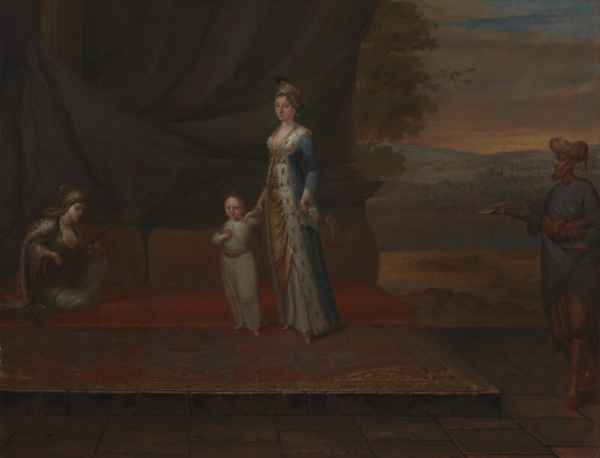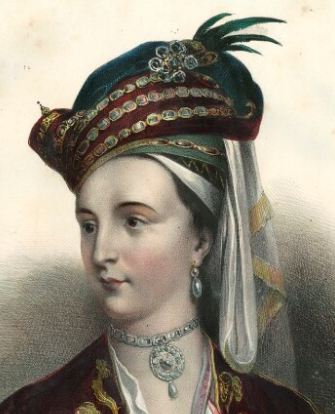Mary Wortley Montague was certainly not the first European to observe medical practices in Constantinople. Nor was she the first visitor in the city to arrange variolation against smallpox for a child (her own son, Edward Wortley Montagu the younger). But she is thought to have been the first to encourage the practice when she returned to London, enabling the procedure to be carried out on a second child (her daughter Mary, later countess of Bute) and playing an active role to raise awareness of the potential for widespread immunity against the disease. At the time, such advocacy of variolation made her well-enough known for members of the public to ‘hoot at her as an unnatural mother’, for predictions to be voiced of ‘failure and the most disastrous consequences’, and for the clergy to decry ‘the impiety of thus seeking to take events out of the hand of Providence’.[1. See Lady Mary Wortley Montagu: essays, poems and ‘Simplicity: a comedy’, ed. R. Halsband and I. Grundy (1976), ‘Biographical Anecdotes’, written by her granddaughter Lady Louisa Stuart, pp. 35–6.]

Lady Mary Wortley Montagu with her son, Edward Wortley Montagu, and attendants, attributed to Jean Baptiste Vanmour. c. 1717. Oil on canvas. (© National Portrait Gallery, London, NPG 3924)
Smallpox was a killer. Many, including Voltaire, wrote of the fearsome mortality rate for those who caught the disease at that time. Early modern individuals fortunate enough to survive infection were scarred for life. Lady Mary Wortley Montagu, born Mary Pierrepont in 1689, lost her brother to smallpox; she herself contracted the virus not long after she had moved to London as a young wife, and her looks were ruined—she claimed she was left with ‘tokens of its passage, for it deprived her of very fine eye-lashes; which gave a fierceness to her eyes that impaired their beauty’.[2. Ibid, p. 35.]
None of this prevented Lady Mary from pursuing a life of adventure, however, and from travelling through Europe first to accompany her husband, the diplomat Edward Wortley Montagu (1678–1761), on his embassy to Constantinople and later, once her children were older, through France and Italy in the hope of arranging a rendezvous with the young man who was at that point the elusive object of her considerable attention: none other than Venetian polymath Francesco Algarotti (1712–1764). As can be seen from the calendar of her correspondence, which was published last week in EMLO, these romantic yearnings were not to be realized but, fortunately for us, Lady Mary wrote with constancy and at length as she travelled. An array of fascinating acquaintances may be found among her correspondents, including the English poet Alexander Pope (with whom she had an infamous ‘parting of ways’); the bishop of Salisbury and historian Gilbert Burnet; the Italian mathematician and writer Antonio Conti; and the French playwright Jean-Baptiste Rousseau. Thanks to the careful work of Robert Halsband, on whose three-volume edition this calendar is based courtesy of our partners Oxford Scholarly Editions Online [OSEO] at Oxford University Press, we are able to consider within her correspondence the curious body of letters known as ‘the Embassy letters’ that date from her husband’s two year posting in Constantinople.[3. For an explanation of the status of ‘the Embassy letters’, see The Complete Letters of Lady Mary Wortley Montagu, ed. Robert Halsband, 3 vols (Oxford: Oxford University Press, 1965), vol. 1, pp. xiv–xvii.]

Lady Mary Wortley Montagu, by Achille Devéria, printed by François Le Villain, published by Edward Bull, published by Edward Churton, after Christian Friedrich Zincke. Hand-coloured lithograph, 1830s. (© National Portrait Gallery, London, NPG D34619)
Do explore the life, the letters, and the legacy of this remarkable early modern woman. The texts of all the letters in Robert Halsband’s edition may be consulted within a subscribing library or institution via links from EMLO’s letter records, as may the entries on Lady Mary and members of her family—as well as many of her correspondents—in the Oxford Dictionary of National Biography [ODNB]. It is worth following the unfortunate career of Mary’s son Edward, who underwent inoculation as a child and thus was spared death or maiming by smallpox. Much good this did him: despite election as a Fellow to the Royal Society, he has come down to posterity classified as a ‘traveller and criminal’ (causing one of my colleagues, who shall remain nameless, to comment: ‘just look at the types they were electing to the Royal Society in the eighteenth century!’). The fact that young Edward contested the Will of his father, the elder Edward, in 1761 was the reason Lady Mary, herself terminally ill, set out from Venice to return for the final time to her homeland. A pioneering and independent woman, she died in London the following summer and was buried in Grosvenor Chapel, South Audley Street.
